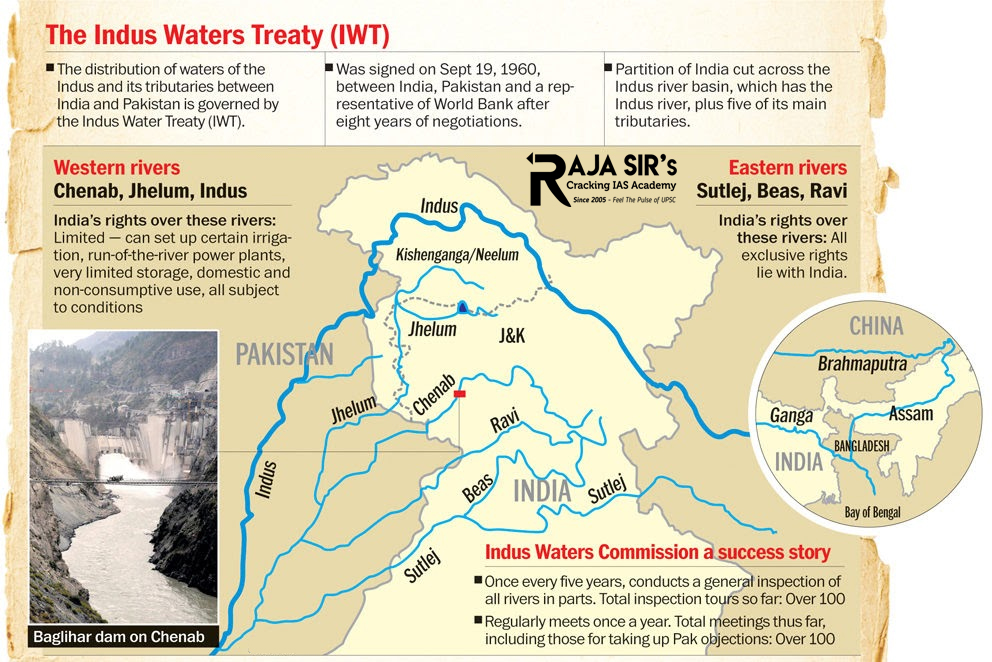- Home
- Prelims
- Mains
- Current Affairs
- Study Materials
- Test Series
 EDITORIALS & ARTICLES
EDITORIALS & ARTICLES
India and Pakistan signed the Indus Waters Treaty on September 19, 1960, after nine years of negotiations. However time is ripe enough to revise and modification of the same. Discuss.
Indus Waters Treaty
- India and Pakistan signed the IWT in September, 1960 after nine years of negotiations,with the World Bank being a signatory to the pact.
- The treaty sets outa mechanism for cooperation and information exchange between the two sides on the use of the water of the Indus River and its five tributaries Sutlej, Beas, Ravi, Jhelum, and Chenab.
Major Provisions
-
- Water Sharing:
- The treaty prescribed how water from the six rivers of the Indus River System would be shared between India and Pakistan.
- It allocated the three western rivers—Indus, Chenab and Jhelum—to Pakistan for unrestricted use, barring certain non-consumptive, agricultural and domestic uses by India and the three Eastern rivers—Ravi, Beas and Sutlej—were allocated to India for unrestricted usage. This means that 80% of the share of water went to Pakistan, while leaving the rest 20% of water for use by India.
- Permanent Indus Commission:
- It also required both the countries to establish a Permanent Indus Commission constituted by permanent commissioners on both sides.
- According to the provisions of the IWT, the Permanent Indus Commission is required to meet at least once a year.
- Rights over Rivers:
- While Pakistan has rights over the waters of Jhelum, Chenab and Indus, Annexure C of the IWT allows India certain agricultural uses, while Annexure D allows it to build ‘run of the river’ hydropower projects,meaning projects not requiring live storage of water.
- Dispute Resolution Mechanism:
- The IWT provides a three-step dispute resolution mechanism under Article IX of the Indus Waters Treaty,under which “questions” on both sides can be resolved at the Permanent Commission, or can also be taken up at the inter-government level.
- In case of unresolved questions or “differences” between the countries on water-sharing, such as technical differences, either side can approach the World Bank to appoint a Neutral Expert (NE)to come to a decision.
- And eventually, if either party is not satisfied with the NE’s decision or in case of “disputes” in the interpretation and extent of the treaty, matters can be referred to aCourt of Arbitration.
- Water Sharing:
Review needed
- Furthermore, it is time for India and Pakistan, as well as other countries in the region, to develop conservation policies rather than focusing on increasing storage capacity, as they have done for so long. Dams are complicated environmental challenges. They are costly to construct, entail habitat loss and heritage destruction, and require the evacuation of entire communities. Climate change is causing the melting of ice in the Tibetan plateau, which researchers believe will affect the river in future. Hence, water must be treated as a valuable commodity. It is critical to establish a joint organization with representatives from both countries, whose functions would include identifying the basin’s short- and long-term supply capacity, as well as its integrated development, infrastructure development, and coordination of the various technical agencies’ activities.
- Additionally, political factors must be taken into account, especially given the current state of distrust in India-Pakistan relations and their long history of resentment. Hence the two countries should seek international assistance, possibly with the World Bank as the primary negotiator for a comprehensive water sharing and utilization arrangement.
Additional Info










 Latest News
Latest News General Studies
General Studies